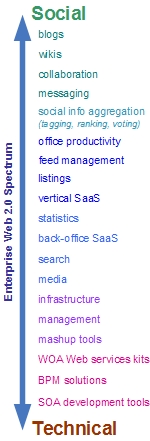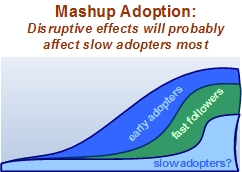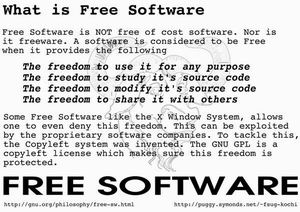Scenario 1: Mashup Mania
Bahadir Baran Odevci
2006 – 2008
Mashup adoption follows the usual curve. Enthusiasts first, then early adopters, then fast followers, and finally, after 2008, it's been happening so long its old news, slow adopters. Social content aggregation starts off with blogs and wikis, although primarily wikipedia, and manages to earn the ordinary internet user buy-in. The Web 2.0 concept finds its shape, information sharing amongst internet users, and web being the center of social information aggregation is called amateurism of the web. It is a wave, more users are keen on sharing information. There is ongoing research about the causes of this behavioral change. One of the key findings is the limited interactivity characteristic of user information sharing or so called “blogging” experience. It is dwelled in a moment in history when traditional interactive technologies—telephone, instant messaging, email, chat —have created a surfeit of interaction. It is concluded that maybe information sharing is happening now because people are ready as internet users to reflect, to “think by writing,” to opine, and advise. People are also ready as readers to seek the “voice” that social content aggregators develop, without having to be in intense conversation with that voice.
The tenets of Web 2.0 are exhibited in a variety of ways that range across a spectrum with social aspects at one end to primarily technical ones at the other (figure below).
The general idea behind mashup software together with Web 2.0 is declared to be online, open, made of pieces, encourages constructive social interaction, and is driven slightly more by its users and data than specific features. Wikis are a great example of this latter concept; their biggest two features are the edit and save buttons, with the data and people gathering there being far more important.
A real issue with many mashups is that they want to combine the data from Web services from over the Web. Ironically, during this period, the browser security sandbox really discourages this. In reality, many mashups do the mashup part on the server because of this restriction. Using the Web as a world-wide SOA isn't going to happen until this problem is solved. The sandbox can be worked around with quite a bit of effort today but there needs to be a one-size fits all browser solution.
The idea of Mashup awakens an awareness in the Enterprise IT. Many, if not all, Enterprise applications include tagging, collaborative markup. In many ways the penetration of “Mashup-like” technologies are perceived as easy. A large part of Enterprise IT’s budget is spent on application integration. The challenge for mashup techniques is declared to be the balance between ease of use and sophistication. Microsoft Office enables desktop mashups– access multiple information sources with Excel and Access and render new dynamic reports in Word. Users are aware of the fact that it is not enough for most of them. Robust enough for mission critical IT, nor secure enough to place in the cloud for universal access. There is a latent demand for a ‘long tail’ of user applications. Mashup technologies, starting by the end of 2007, act as the response to empowering end users to create Web 2.0 solutions.
Sites likes Programmable Web do an amazing job making it easy to find the API you're looking for. But it is a far cry from the formalism of UDDI, the Web services directory standard. This means sorting through APIs is done manually during this period and is not tool aided.
In 1960s and 1970s, software was seen as an add-on supplied by mainframe vendors to make computers useful. Late 1970s and early 1980s companies began routinely imposing restrictions on programmers with software license agreements. Sometimes this was because companies were now making money from proprietary software or they were trying to keep hardware characteristics secret by hiding the source code. Other times it was because of the increasingly corporatised attitude in the growing and previously eclectic industry saw protecting source code and trade secrets as a norm even if it didn't provide any benefit to business. 1983 Richard Stallman launched the GNU project after becoming frustrated with the effects of the change in culture of the computer industry and users. One incident was when a printer wouldn't work but he couldn't hack the source code to fix the problem because it was withheld. Software development for the GNU operating system began in January 1984, and Free Software Foundation (FSF) was founded in October 1985. He introduced a free software definition and "copyleft", designed to ensure software freedom for all. At present day free software is a huge international effort, producing software used by individuals, large organisations, and even entire countries. The economic advantages of the free software model, and, to a lesser extent, the ethical principles that it was founded upon are beginning to be recognised, even by mainstream media. Also, some other industries — that is, non-software industries — are beginning to recognise the value of free software's message too: scientists, for example, are looking towards more open development processes, and hardware such as microchips is beginning to be developed under Copyleft licenses (the OpenCores project, for instance). The Creative Commons and Open Content movements have also been largely influenced by free software.
2008 – 2012
Mashups, like Ajax, become a disruptive technology, meaning that they become a genuine threat to the old way of doing things. EAI and composite application technology from SOAs turns out to be declared as the old, traditional way of software application development.
Due to vast contribution of the online users in terms of information sharing, social information aggregators increase in number. Blogs are featured extensively in the popular media and have entered political campaigns, news organizations, businesses, and classrooms. Blog sites devoted to politics and punditry, to news, and to sharing technical developments, receive thousands of hits a day. Tagging, ranking, voting of information is widely made available to users by mashup sites. Unprecedented numbers of web services that leverage the information comes into being. Feed management, search capabilities, collaboration and wikis continue to boost mashup ecosystem. Researches indicate that, there is a form of object-oriented communicative activity, enacting a wide variety of social purposes, which leads the rise of mashup services that are driven by users and data.
Mashup software for the enterprise effectively demonstrates social and technological aspects. Mashup tools emerge, BPM solutions and SOA development suits of products incorporate mashup capabilities, techniques and design patterns into their solutions. Mashup Web Services toolkits leverage a common standard devised by consortium comprising software giants Microsoft, IBM and Oracle. In order to solve the cross-domain security problem, the same consortium, including the Mozilla corporation, reveals a common framework for mashup development API, that is to be launched as a plug-in for all available web browsers.
Special kind of business user evolves in business units. A knowledge worker who is adept at leveraging the power of SOBAs to meet ever-changing business needs. While some knowledge workers have the technical capabilities necessary to construct mashups of 2006 and 2008, the true promise of SOBAs depends upon user interfaces sophisticated enough for a broader business audience to use. Enterprises already had knowledge workers at this level: people who are proficient with Microsoft Excel. Not only does Excel make a powerful SOBA consumer in its own right, but the technical skill people need to get value out of an application like Excel is the level SOBA tools vendors are targeting when building SOBA interface applications. Tools as such are unveiled during this period, the writing is on the wall: the enterprise mashup is for the SOBA consumer.
During 2008, the concept of 'transactional' mashups emerge. Transactional mashups are full-fledged web applications in which users can not only view (read) mashed up data, but do transactions with that data within the mashup. In "eBay Motors" for example, users can actually complete the purchase of a car from within the mashup itself - instead of being directed to the eBay website. The value would remain the same for eBay, who get the same cut of the action. eBay finds purchases increase, because the user can do everything from the one place (the mashup site). It would almost certainly mean more value for the mashup, because users would be able to do more things on the mashup site - which gives more monetization opportunities (e.g. advertising).
A real universal registry for mashup APIs gets figured out. Sorting through APIs is no more done manually and is sorted out tool aided. A new release of the UDDI standard, namely 4.0, includes the tool support for API for description, discovery and integration of mashup services,
Starting from 2012, slow adopters are the never adopters, because they're cancelled, compelled to retire from full workload, given special projects. Fast-moving people and companies with good mashup tools and a vast landscape of services can develop 10 smaller applications that not only do what old ways of building software did, but are in turn reusable and composable.
Collaboration is a feature, not a purpose. Collaboration becomes a feature of business process applications the way printing is feature of desktop applications. Many Enterprise applications in the Enterprise are not in the Enterprise at all. Users collaborate in the cloud, not in the desk. Think “expense tracking and reporting”, “personnel reviews”, “sales force collaboration,” and all the other micro processes that plague every enterprise, big and small. As people work on the road, from home, or on mobile phones, they remain part of these long running processes that reach outside the firewall.
Enterprise mashups enables the business users getting the direct control over the business processes and business rules that govern how enterprise applications behave. Business units are dominated by business users possessing analytical and conceptual thinking skills. The new breed of business users are capable of engineering their business, they can easily assemble, tailor, change and maintain enterprise mashups. The number of employees in traditional IT departments decrease, and even internal IT departments are closed off, instead, traditional function of IT departments spread throughout the organization.
Due to the releases of UDDI and Mashup interactive development environment released by the open source community, Mashup APIs and services sprout up like wildflowers inside and outside the firewall and it is very tempting to mash them up.
The software industry returns to be about a free exchange of ideas and code. Lengthy, but temporary period during which software was a proprietary, closed science is responded. The consequences of that process produced bad software at high prices, and the situation is reversed. People think well and share.
Major software vendors copied the innovation of individual software developers to make a profit at the expense of users. The environment is changed to make their business model impossible, sharing produces better technology at lower prices and enables people to succeed in all sorts of social and economic endeavors.
References
http://blogs.zdnet.com/service-orientated/?p=550
How to add a Google Map to any web page in less than 10 minutes, from http://blog.explorationage.com/articles/2006/01/08/how-to-add-a-google-map-to-any-web-page-in-less-than-10-minutes
http://zapthink.com/report.htm/?id=ZAPFLASH-2006320
Rethinking BPM in a mashup-based SOA world, from http://blogs.zdnet.com/BTL/?p=2517
Some predictions for the coming 'mashosphere', http://blogs.zdnet.com/Hinchcliffe/index.php?p=13
Some Problems with Mashups, from http://earlystagevc.typepad.com/earlystagevc/2006/02/the_problems_wi.html
Mashups, remix and copyright law, Bamien O'Brien and Professor Brian Fitzgerald
Web 2.0 and Service Oriented Architectures (SOA), from http://www.advancinginsights.com/mybiz/web-2-0-and-soa
So What Does Web 2.0 in the Enterprise Look Like?, from http://earlystagevc.typepad.com/earlystagevc/2006/05/so_what_does_we.html
Mashup Business Models, from http://www.readwriteweb.com/archives/mashup_business.php
Mashup ecosystem poised to explode, from http://blogs.zdnet.com/BTL/?p=2484
Clint Boulton, 2005, The Future of Free Software Lies in The Past, from http://www.internetnews.com/dev-news/article.php/3508051
Foundation for a Free Information Infrastructure, from http://www.ffii.org/index.en.html
The Free Software Definition, from http://www.gnu.org/philosophy/free-sw.html
Philosophy of the GNU Project, http://www.gnu.org/philosophy/
NITLE Blog Census, from http://www.blogcensus.net/?page=Home
Blogging as social activity, or, would you let 900 million people read your diary?, 2004, Bonnie A. Nardi, Diane J. Schiano, Michelle Gumbrecht, ACM Press New York, NY, USA , from http://home.comcast.net/~diane.schiano/CSCW04.Blog.pdf



